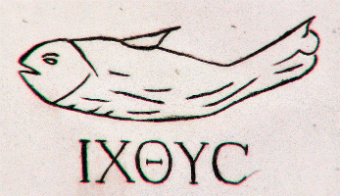Christian Symbolism in the Catacombs

The primitive Christian symbolism of the catacombs tell much about the early Believers, their faith and how they died. The sacred signs found throughout the darkened underground tombs were there to convey a message about the light of Jesus as comfort to both the living and the dead.
Early Christian paintings illustrate the power and glory of Christ. They tell the story of Christ and his life. According to art historian Clara Erskine Clement "The paintings of the catacombs date from the third and fourth centuries after Christ. The catacombs, or burial-places of the early Christians, consist of long, narrow, subterranean passages, cut with regularity, and crossing each other like streets in a city. The graves are in the sides of these passages, and there are some larger rooms or chambers into which the narrow passages run. There are about sixty of the catacombs in and near Rome; they are generally called by the name of some saint who is buried in them. The paintings are in the chambers, of which there are sometimes several quite near each other. The reason for their being in these underground places was that Christians were so persecuted under the Romans, that they were obliged to do secretly all that they did as Christians, so that no attention should be attracted to them.The principal characteristics of these pictures are a simple majesty and earnestness of effect; perhaps spirituality is the word to use, for by these paintings the early Christians desired to express their belief in the religion of Christ, and especially in the immortality of the soul, which was a very precious doctrine to them. The catacombs of Rome were more numerous and important than those of any other city.
Many of the paintings in the catacombs had a symbolic meaning, beyond the plainer intention which appeared at the first sight of them: you will know what I mean when I say that not only was this picture of Moses striking the rock intended to represent an historical fact in the life of Moses, but the flowing water was also regarded as a type of the blessing of Christian baptism."
The Fish is a very early Christian symbol found in inscribed upon the walls of the Catacombs from the first century. The Greek word for fish, Ichthys, upon which a rebus ( word puzzle which uses pictures to represent words or parts of words) was created, is derived from the first letters of Greek words meaning "Jesus Christ, son of God, Savior."
The Good Shepard is a Christian symbols in found in the Christian underground burial chamebers. The Good Shepherd symbolizes Christ the Savior "I am the Good Shepherd: the Good Shepherd giveth His life for His sheep" (John 10:11) The Shepherd represents Jesus who will search devotedly for even one lost Child of God until it is found. (Luke 15)
The anchor represents hope in Jesus The anchor symbolizes the concept of steadfastness, safety, and trust because it represents the safe arrival of the ship in harbor after a perilous voyage at sea. The anchor hidden in the Cross symbolizes the Christian’s salvation in Christ and the arrival of the soul in the harbor of everlasting life. The anchor is a symbol the commitment of the believer to the Christian faith.
Require more information and facts about Christian Symbolism in
the Catacombs? Poke around every nook and cranny of the known universe
for information this subject.
Search Here
© HistoryofPainters.com If you like this page and wish to share it, you are welcome to link to it, with our thanks.
If you feel you have worthwhile information you would like to contribute we would love to hear from you. We collect essential biographical information and artist quotes from folks all over the globe and appreciate your participation. When submitting please, if possible, site the source and provide English translation. Email to millardmulch@gmail.com
The Meaning of Sacred Symbols in Paintings. Most prominently featured symbols and their meaning:
- The Serpent
- Good Shepherd
- Key
- Wheat
- Virgin Mary
- Christ
- The Anchor
- The Apostles
- Satan
- Chalice
- The Cross
- Fruit
- The Saints
- Colors
- Book
- Birds
- Angels
- Insects
- Fish
- Spider
- Animals
- Household Objects